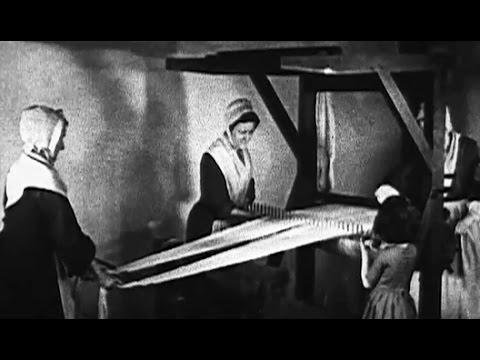The Art of Spinning and Weaving circa 1920 Boston Museum of Fine Arts
more at
“Women in period costumes demonstrate spinning and weaving as done throughout history.” Silent.
Public domain film from the Prelinger Archives, slightly cropped to remove uneven edges, with the aspect ratio corrected, and mild video noise reduction applied.
The soundtrack was also processed with volume normalization, noise reduction, clipping reduction, and/or equalization (the resulting sound, though not perfect, is far less noisy than the original).
The origins of spinning fiber to make string or yarn are lost in time, but archaeological evidence in the form of representation of string skirts has been dated to the Upper Paleolithic era, some 20,000 years ago. In the most primitive type of spinning, tufts of animal hair or plant fiber are rolled down the thigh with the hand, and additional tufts are added as needed until the desired length of spun fiber is achieved. Later, the fiber is fastened to a stone which is twirled round until the yarn is sufficiently twisted, whereupon it is wound upon the stone and the process repeated over and over.
The next method of spinning yarn is with the spindle, a straight stick eight to twelve inches long on which the yarn is wound after twisting. At first the stick had a cleft or split in the top in which the thread was fixed. Later, a hook of bone was added to the upper end. The bunch of wool or plant fibers is held in the left hand. With the right hand the fibers are drawn out several inches and the end fastened securely in the slit or hook on the top of the spindle. A whirling motion is given to the spindle on the thigh or any convenient part of the body. The twisted yarn is then wound on to the upper part of the spindle. Another bunch of fibers is drawn out, the spindle is given another twirl, the yarn is wound on the spindle, and so on.
The distaff was used for holding the bunch of wool, flax, or other fibers. It was a short stick, on one end of which was loosely wound the raw material. The other end of the distaff was held in the hand, under the arm or thrust in the girdle of the spinner. When held thus, one hand was left free for drawing out the fibers.
A spindle containing a quantity of yarn rotates more easily, steadily, and continues longer than an empty one; hence, the next improvement was the addition of a weight called a spindle whorl at the bottom of the spindle. These whorls are discs of wood, stone, clay, or metal with a hole in the center for the spindle, which keep the spindle steady and promote its rotation. Spindle whorls appeared in the Neolithic era…
In mediæval times, poor families had such a need for yarn to make their own cloth and clothes that practically all girls and unmarried women would keep busy spinning, and “spinster” became synonymous with an unmarried woman…
A great wheel (also called a wool wheel, high wheel or walking wheel) is advantageous when using the long-draw technique to spin wool or cotton because the high ratio between the large wheel and the whorl (sheave) enables the spinner to turn the bobbin faster, thus significantly speeding up production.
A Saxony wheel (also called a flax wheel) or an upright wheel (also called a castle wheel), can be used to spin wool or cotton, but are invaluable when spinning flax (linen). The ends of flax fibers tend to stick out from the thread unless wetted while being spun. The spinner typically keeps a bowl of water handy when spinning flax, and on these types of wheels, both hands are free (since the wheel is turned with a treadle, rather than by hand), so the spinner can use one hand to draft the fibers and the other to wet them…
Weaving is a method of fabric production in which two distinct sets of yarns or threads are interlaced at right angles to form a fabric or cloth. The other methods are knitting, lace making, felting, and braiding or plaiting. The longitudinal threads are called the warp and the lateral threads are the weft or filling. (Weft or woof is an old English word meaning “that which is woven”.) The method in which these threads are inter woven affects the characteristics of the cloth.
Cloth is usually woven on a loom, a device that holds the warp threads in place while filling threads are woven through them. A fabric band which meets this definition of cloth (warp threads with a weft thread winding between) can also be made using other methods, including tablet weaving, back-strap, or other techniques without looms.
The way the warp and filling threads interlace with each other is called the weave. The majority of woven products are created with one of three basic weaves: plain weave, satin weave, or twill. Woven cloth can be plain (in one colour or a simple pattern), or can be woven in decorative or artistic designs…

